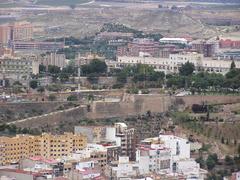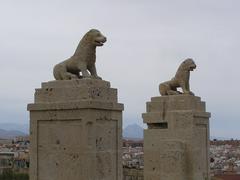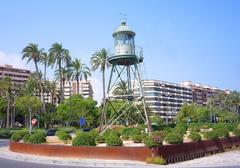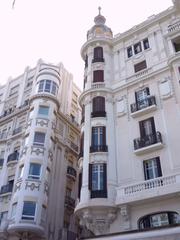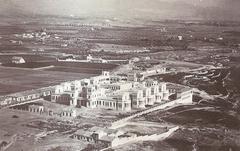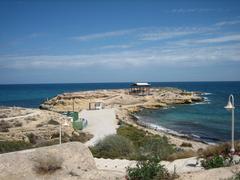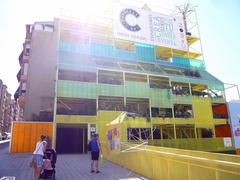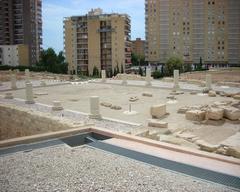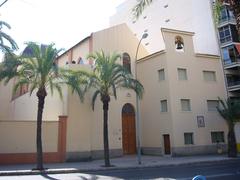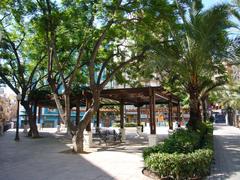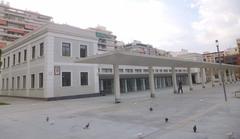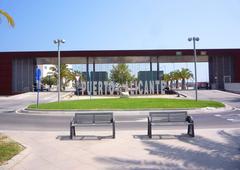
Guide to Visiting Castell de Sant Ferran, Alicante, Spain
Published Date: 19/07/2024
Introduction to Castell de Sant Ferran
Nestled in the vibrant city of Alicante, Spain, Castell de Sant Ferran, also known as the Castle of Saint Ferdinand, is a fortress of immense historical and cultural significance. Constructed during the early 19th century under the orders of the Duke of Wellington, Arthur Wellesley, it was a strategic military installation during the Peninsular War, part of the larger Napoleonic Wars (Alicante Tourism). Its architectural prowess, featuring bastions, ramparts, and a moat, showcases the military engineering advancements of the time (Spain.info). Over the years, Castell de Sant Ferran has evolved from a pivotal stronghold to a treasured historical landmark, attracting visitors keen on exploring its storied past and architectural beauty. Today, it stands as a testament to Alicante’s resilience and strategic importance, offering panoramic views, cultural events, and educational programs that enrich the visitor experience (War History Online, Heritage Daily). This comprehensive guide delves into the history, visitor information, and travel tips for Castell de Sant Ferran, ensuring a memorable and insightful visit.
Contents
- Introduction
- Origins and Construction
- Architectural Design
- Role in the Peninsular War
- Post-War Period and Decline
- Restoration and Preservation Efforts
- Modern-Day Significance
- Visitor Experience and Tips
- Educational Programs
- Cultural Impact
- Nearby Attractions
- Santa Bárbara Castle
- Explanada de España
- Archaeological Museum of Alicante (MARQ)
- Visitor Information
- Ticket Prices and Opening Hours
- Travel Tips and Nearby Attractions
- Special Events and Guided Tours
- Frequently Asked Questions
- Conclusion
Castell de Sant Ferran - History and Visiting Guide
Origins and Construction
The Castell de Sant Ferran, also known as the Castle of Saint Ferdinand, is a significant historical fortress located in Alicante, Spain. The castle’s construction began in 1813 during the Peninsular War, a conflict that was part of the larger Napoleonic Wars. The fortress was built under the orders of the Duke of Wellington, Arthur Wellesley, to strengthen the city’s defenses against French forces. The strategic location of Alicante, with its proximity to the Mediterranean Sea, made it a crucial point of defense (Alicante Tourism).
Architectural Design
The design of Castell de Sant Ferran reflects the early 19th-century military architectural styles. The fortress was constructed using local materials, primarily limestone, which was abundant in the region. Its layout includes bastions, ramparts, and a moat, typical features of military fortifications of that era. The bastions provided vantage points for artillery, while the ramparts and moat added layers of defense against potential sieges (Spain.info).
Role in the Peninsular War
During the Peninsular War, Castell de Sant Ferran played a pivotal role in the defense of Alicante. The fortress served as a stronghold for British and Spanish forces resisting the French invasion. Its strategic position allowed for effective control over the surrounding area and the Mediterranean coastline. The castle’s defenses were tested during several skirmishes, but it successfully withstood attacks, contributing to the eventual withdrawal of French forces from the region (War History Online).
Post-War Period and Decline
After the conclusion of the Peninsular War, Castell de Sant Ferran continued to serve as a military installation. However, its significance gradually diminished as new military technologies and strategies emerged. By the late 19th century, the fortress was largely abandoned and fell into a state of disrepair. The decline of the castle mirrored the broader trend of decommissioning older fortifications across Europe as they became obsolete in the face of modern warfare (Alicante History).
Restoration and Preservation Efforts
In the 20th century, efforts to preserve and restore Castell de Sant Ferran began to take shape. Recognizing its historical and cultural value, local authorities initiated restoration projects aimed at stabilizing the structure and preventing further decay. These efforts included repairing the walls, clearing vegetation, and installing informational plaques to educate visitors about the castle’s history. The restoration work has been ongoing, with significant progress made in recent decades (Heritage Daily).
Modern-Day Significance
Today, Castell de Sant Ferran stands as a testament to Alicante’s rich historical heritage. The fortress is a popular tourist attraction, drawing visitors from around the world interested in its historical significance and architectural beauty. The castle offers panoramic views of Alicante and the Mediterranean Sea, making it a favored spot for photography and sightseeing. Additionally, the site hosts various cultural events and exhibitions, further enhancing its role as a center of historical and cultural education (Alicante Tourist Guide).
Visitor Experience and Tips
For those planning to visit Castell de Sant Ferran, there are several tips to ensure a memorable experience. The castle is accessible by foot from the city center, and guided tours are available that provide in-depth information about its history and architecture. Visitors are encouraged to wear comfortable footwear, as the terrain can be uneven. The best time to visit is during the spring and autumn months when the weather is mild, and the crowds are smaller. The castle grounds offer picnic areas, making it a great spot for a leisurely day out. Tickets can be purchased online or at the entrance, and the opening hours are from 10 AM to 6 PM daily. For more details, visit the official Castell de Sant Ferran website.
Educational Programs
Castell de Sant Ferran also offers educational programs for schools and groups. These programs include guided tours, interactive workshops, and historical reenactments that provide a hands-on learning experience. The educational initiatives aim to foster a deeper understanding of the castle’s historical context and its role in shaping the region’s history. These programs are particularly popular among local schools and history enthusiasts (Alicante Education).
Cultural Impact
The cultural impact of Castell de Sant Ferran extends beyond its historical significance. The fortress has become a symbol of Alicante’s resilience and strategic importance throughout history. It is featured in various local legends and folklore, adding to its mystique and allure. The castle’s image is often used in promotional materials and souvenirs, further cementing its status as an iconic landmark of Alicante (Cultural Heritage of Alicante).
Nearby Attractions
When visiting Castell de Sant Ferran, there are several nearby attractions worth exploring. The Santa Bárbara Castle, another historic fortress, offers additional insights into Alicante’s military past. The Explanada de España, a picturesque promenade, is perfect for a leisurely stroll. The Archaeological Museum of Alicante (MARQ) provides a deeper dive into the region’s rich history. These sites, along with the beautiful beaches of Alicante, ensure a well-rounded and enjoyable visit.
Visitor Information
Ticket Prices and Opening Hours
As of July 2024, the entry fee for adults is €5.00. Children under 12 and seniors over 65 can enter for free. There are also discounts for students and groups. It’s advisable to check the official website for the latest prices and any special offers. The castle is open daily from 10 AM to 6 PM, with extended hours during peak tourist seasons.
Travel Tips
- By Car: There are several parking options available near the castle. Alicante is well-connected by highways, and the castle is signposted from major routes.
- Public Transport: Alicante’s public transport system is efficient. You can take a bus or tram to the nearest stop and walk to the castle. The Alicante Tram is a convenient option, with several lines connecting different parts of the city.
- Walking: For those staying in the city center, walking to the castle is a pleasant option. The route offers scenic views of Alicante’s historic streets and coastline.
Special Events and Guided Tours
Castell de Sant Ferran hosts a variety of events and activities, such as historical reenactments, cultural performances, and educational workshops. These events provide a dynamic and engaging experience for visitors. Guided tours are available, offering in-depth insights into the history and significance of the fortress.
Frequently Asked Questions
What are the visiting hours for Castell de Sant Ferran?
The castle is open daily from 10 AM to 6 PM.
How can I buy tickets for Castell de Sant Ferran?
Tickets can be purchased online or at the entrance.
Are there guided tours available?
Yes, guided tours are available that provide in-depth information about the castle’s history and architecture.
Is Castell de Sant Ferran accessible by foot?
Yes, the castle is accessible by foot from the city center.
What is the best time to visit Castell de Sant Ferran?
The best time to visit is during the spring and autumn months when the weather is mild, and the crowds are smaller.
Conclusion
The significance of Castell de Sant Ferran extends beyond its historical and architectural value. It is a cultural landmark, an educational resource, and a vital part of the local economy. The ongoing preservation efforts and the dynamic visitor experience ensure that the fortress remains a valuable and cherished part of Alicante’s heritage. For more information and to plan your visit, you can check the official website. For the latest updates, consider downloading the Audiala mobile app or following on social media.
Sources and References
- Alicante Tourism. Retrieved from https://www.alicanteturismo.com
- Spain.info. Retrieved from https://www.spain.info
- War History Online. Retrieved from https://www.warhistoryonline.com
- Heritage Daily. Retrieved from https://www.heritagedaily.com
